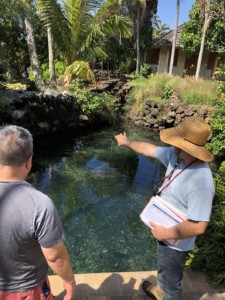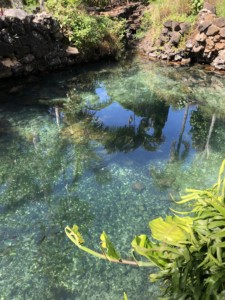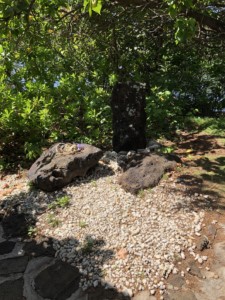Spring Awakening
Kanewai Spring, one of the last freshwater springs in Honolulu, is saved, thanks to relationship building, community outreach and organizing and a lot of yardwork.
Eight years, eight long years.
That’s how long it took for the Maunalua Fishpond Heritage Center to acquire Kanewai Spring, a lava tube-fed, freshwater spring on the grounds of a broken-down estate along East Honolulu’s busy Kalanianaole Highway. It was eight years of relationship building, negotiating, community outreach and organizing, politicking, lawyering, grant writing and fundraising, but, truth be told, most of the nonprofit’s conservation effort was spent doing yardwork.

Chris Cramer tells the story of the rebirth of Kanewai Spring.
In 2010, the property, which hadn’t been occupied for decades, was mired in litigation and tangled by a small forest of haole koa trees when Chris Cramer, President of the Maunalua Fishpond Heritage Center, called the landowners with a proposal. “I shared with them that they had an ancient spring underneath all the invasive vegetation on their property, and we proposed to properly bring it back to health,” says Cramer. “As we got to know the owners, we learned that they wanted to sell the property one day, so I said: ‘Whenever that day comes, we’d like to buy it.’”
When the landowners agreed to the first part of the organization’s proposal, Cramer, a former schoolteacher, and fellow Heritage Center volunteers discovered nearly an acre of dense brush almost two stories high. However, they eventually uncovered a 1,000 square-foot, stagnant spring that had once been the home’s water feature and before that an important source of fresh water for Kanewai Fishpond, once a thriving estuary, which in turn flowed into nearby Paiko Lagoon and then the ocean. After several years of invasive brush clearing by school and community volunteers, the water started to flow again and limu ‘ele‘ele, a brackish-water seaweed, which is an important food source for a web of marine life, began to cover the pool’s rocky floor. ‘Opae ‘oeha‘a and ‘opae huna, small native shrimps, followed, along with pipiwai and hapawai, freshwater limpets, ‘ama‘ama (striped mullet) and āholehole (Hawaiian/Pacific flagtail). Soon, the nearby Kanewai Fishpond, which had been a stinky body of water filled with jellyfish was replenished with a steady flow of freshwater and, eventually, schools of native fish.

“Coincidentally, after we cleared away the brush, the water flow increased and the water quality [of the pond] got much better. The native seaweed started growing back and native birds returned. There aren’t any springs like this in all of East Honolulu. This is the po‘owai, head water spring, of the area. If this isn’t healthy the pond isn’t healthy and the near shore isn’t healthy.”

However, as successful as the Heritage Center’s restoration efforts were, it would be years before the Center’s second proposal would be considered by the property’s landowners.
“For years and years, we cleaned and cleared, and I’d joke with Chris that I had haole koa in my own backyard that I had to get rid of,” says Angela Correa-Pei, Maunalua Fishpond Heritage Center’s vice-president. “But Chris persisted. He got community groups to visit, and we built a relationship with the landowners. Then, one day, they told us they were ready to sell.”
According to Correa-Pei, in 2016, the landowners agreed to sell the property to the Heritage Center. The final asking price was the appraised value of $2.3 million; however, they stipulated that the purchase needed to finalize by May 30, 2017. Suddenly, after years of weed-wacking and waiting, their conservation effort had a drop-dead deadline.
“We didn’t start fundraising efforts before, because we never really knew if we had a chance to own it. Suddenly, they were going to sell it, and we had to move quickly,” says Correa-Pei. “But once we had the agreement of sale, we started the grant writing. It was crazy.”
Through a critical partnership with the Trust for Public Land, they set a goal of raising $2.65 million. The group secured $1 million from City and County of Honolulu’s Clean Water and Natural Lands Fund and was awarded a $1.3 million grant from the State of Hawaii’s Legacy Land Conservation Fund. A year-long fundraising effort raised more than $350,000 to cover the property’s stewardship and taxes for the next couple of years.

kū‘ula (fishing stone shrine) with an upright Kū stone balanced by a low Hina stone where the fishermen of old would have given offerings asking for a plentiful catch.
But things didn’t go so swimmingly for the Heritage Center. At the eleventh hour, bureaucratic and legal delays threatened to run out the clock for the project. Fortunately, the community rallied around the vital importance of the spring to the surrounding area. Hundreds of letters and testimonies were sent by volunteers inspired by the ‘ama‘ama and papio that had returned and the traditional dry-stack stone walls. The testimonies shared about the unique stone fishing shrine, and mākāhā (gate system) and ‘auwai (watercourse) that volunteers had uncovered and restored.
After hearing the passionate community support, local officials agreed to support the purchase, but not before the nonprofit agreed to a number of restrictions, which include limits on the number of events held on site and the number people who can visit at any one time.
“This is a community water source, one of the last of its kind,” says Cramer. “Wailupe was a fishpond, Niu was a fishpond, but their springs got covered up when the area was developed. Other communities can do what we did. There is a pathway. It’s not an easy pathway, but there is one.”
“It’s so important to know your ‘aina. The more you know, the easier it is to convince your community and lawmakers on why your project is so vital and important,” says Correa-Pei. “You show them the fish you have, where the limu is growing. You tell them about the history of the place.”
“I grew up in Kuliouou Valley, where my family has lived since 1912,” continues Correa-Pei. “By the time I was a kid, drainage canals replaced streams, but I can still remember when my family would go fishing and we would lay out the days catch in the yard. I still live here, but my kids don’t have that experience. They don’t know that the bay was once thriving. But this spring is amazing. It brings so much water into Kanewai Pond and Paiko Lagoon and the bay. It so important that we can show people that springs like this still exist.”

Executives and board members of the Maunalua Fishpond Heritage Center and Trust for Public Land gave thanks to previous landowner, Rikuo Corporation.


